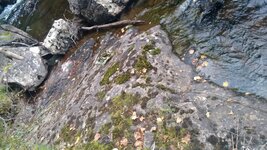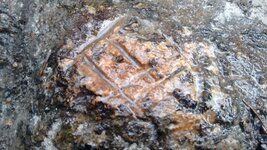leviterande
Tenderfoot
- Sep 3, 2014
- 5
- 2
- Primary Interest:
- All Treasure Hunting
Hi!
So I am in what I believe is a possible potential creek where I found many rusty quartz rocks with small bits of pyrite(also, other rocks where the pyrite is sandwiched between the quartz and the rust; none of them gave any signal). Only things otherwise that gave signal in the entire creek are nails, metal trash, coins found in crevices.
Big red/rusty(?)stained rocks are also here and there but they never give any signal.
Now, here I was scanning a big bedrock outcrop when all of the sudden I got a pretty strong signal on one point on the bedrock where there are no crevices. It is clearly something metallic inside the bedrock. Thus wonder if it is a hot rock. How do I know? No reaction from a magnet and the entire creek is filled with similar huge rocks that have the same color but that dont give any signal. It is only on that bed outcrop that I get a very strong signal when I pass over a point of perhaps 3x3 inches. I halfed the sensitivity and the signal is still there. I swapped from all directions and the signal is as strong on that spot
I tried to break the rock but that seemed fruitless as it was very hard, I really want to know how to find out if it is a hot rock. Any methods on how?
1st pic is the bedrock outcrop. Red circle is around the "hot spot"
2nd pic is the hot spot after trying to break through it w/o success
Thank you for your time and patience
Best Regards
So I am in what I believe is a possible potential creek where I found many rusty quartz rocks with small bits of pyrite(also, other rocks where the pyrite is sandwiched between the quartz and the rust; none of them gave any signal). Only things otherwise that gave signal in the entire creek are nails, metal trash, coins found in crevices.
Big red/rusty(?)stained rocks are also here and there but they never give any signal.
Now, here I was scanning a big bedrock outcrop when all of the sudden I got a pretty strong signal on one point on the bedrock where there are no crevices. It is clearly something metallic inside the bedrock. Thus wonder if it is a hot rock. How do I know? No reaction from a magnet and the entire creek is filled with similar huge rocks that have the same color but that dont give any signal. It is only on that bed outcrop that I get a very strong signal when I pass over a point of perhaps 3x3 inches. I halfed the sensitivity and the signal is still there. I swapped from all directions and the signal is as strong on that spot
I tried to break the rock but that seemed fruitless as it was very hard, I really want to know how to find out if it is a hot rock. Any methods on how?
1st pic is the bedrock outcrop. Red circle is around the "hot spot"
2nd pic is the hot spot after trying to break through it w/o success
Thank you for your time and patience
Best Regards
Amazon Forum Fav 👍
Attachments
Upvote
0




 . the score is till 0:1, couldnt crack the thing, its mighty tough so I gave up. I scanned a huge portion of the entire creek and no other rock/bedrock gave any signal except this one.. hmm. Wonder if there is any cheap powerful portable drill machine somewhere.
. the score is till 0:1, couldnt crack the thing, its mighty tough so I gave up. I scanned a huge portion of the entire creek and no other rock/bedrock gave any signal except this one.. hmm. Wonder if there is any cheap powerful portable drill machine somewhere.